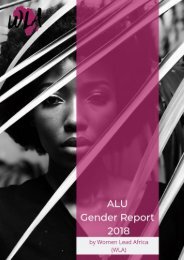You also want an ePaper? Increase the reach of your titles
YUMPU automatically turns print PDFs into web optimized ePapers that Google loves.
Methodology<br />
The report is grounded in insights gained by analysing data from primary and secondary research<br />
we conducted with the aim to understand gender parity issues within universities, the work place in<br />
Africa and more importantly here at ALU.<br />
Primary Research<br />
Our primary research comprised of an online<br />
survey and focus group discussions. The<br />
primary research has excluded First year<br />
students as at the time of research (February,<br />
<strong>2018</strong>) as they had only been at ALU for a<br />
period of 4 months, and we believed their<br />
experience is relatively limited.<br />
Secondary research<br />
Our secondary research encompassed critical<br />
literature review of gender parity reports from<br />
corporates operating in Africa and top-tier<br />
universities across the globe. Some of the key<br />
reports reviewed include Women Matter<br />
Africa (Mckinsey, 2016), Women in the<br />
workplace (Mckinsey, 2017), Gender disparity<br />
in South Africa (Bain, 2017), The status of<br />
undergraduate women at MIT (MIT, 2016) and<br />
The simple truth (American Association of<br />
university women, 2017) and Mckinsey Global<br />
Institute <strong>Report</strong> (MGI, 2017). In reviewing<br />
these reports, we have gained insights on<br />
[Add insights that we were looking for in the<br />
reports]. Another aspect of our secondary<br />
research was evaluating key articles and<br />
journals on the history of African women and<br />
their evolution in tertiary institutions<br />
Online Survey<br />
Our online survey consisting of 38 questions was<br />
distributed to 132 selected sample of students<br />
(52% of the population size) and received rate<br />
responses and received an 88.6% response rate<br />
accounting 117 students. Survey respondents were<br />
47% Female and 53% Male, fairly representing the<br />
student body composition of 41% Female and<br />
59% Male students. In order to select online<br />
survey participants, a stratified sampling was used<br />
to to ensure proportional representation of<br />
gender, year of study and the different majors.<br />
Survey results were then analysed and discussed<br />
by using group comparison, T-test analysis to<br />
determine significant differences between female<br />
and male groups being compared under various<br />
variables.<br />
Focus group discussions<br />
We held a total of 6 focus group discussion with<br />
close to 50 selected sample of students. The<br />
students were grouped according to gender, study<br />
year and major alternatively for the different group<br />
discussions held. Stories shared in focus group<br />
discussions were used to give an in-depth<br />
perspective of gender parity issues that stood in<br />
our online survey responses.<br />
24




